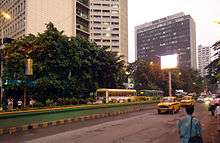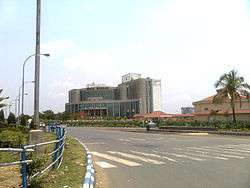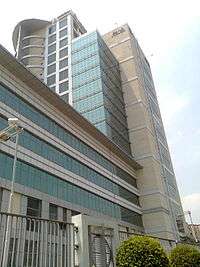Economy of Kolkata

.jpg)
Kolkata is the main business, commercial and financial hub of eastern India and the main port of communication for the North-East Indian states, It is one of the most important metros of India. Recent estimates of Kolkata's economy have ranged from $60 to $150 billion (GDP adjusted for purchasing power parity) making it third most-productive metropolitan area in India, after Mumbai and Delhi. Kolkata is home to India's oldest, and also India's second-largest stock exchange company (bourse)[1] – The Calcutta Stock Exchange. Kolkata is home to a major port, an international airport and many nationally and internationally reputed colleges and institutions aimed at supplying a highly skilled work force.[2] Kolkata is also home to India's and South Asia's first metro railway service – Kolkata Metro.[3]
There are a few of the oldest and front line banks and PSUs in India—such as UCO Bank, Allahabad Bank, United Bank of India and Tea Board of India—were founded and is headquartered in Kolkata. The oldest operating photographic studio in the world, Bourne & Shepherd, is also based in the city. The Standard Chartered Bank has a major branch in Kolkata.[4] Kolkata is also the headquarters of Botanical Survey of India and Zoological Survey of India and many more organisations and companies. Moreover, due to the recent efforts of the Government of West Bengal as well as the people of kolkata the economy is looking to rise to even greater heights.
Economic history and recent developments
.jpg)
Kolkata was the capital of the British Indian Empire until 1911. Throughout British Raj, the city was a major port and commerce center in world economy. The Partition of India in 1947 was a major blow to the once flourishing economy during the world wars, it removed most of the hinterland, cutting down the supply of the human resource and a took away a huge portion of its market. Also the huge inflow of refugee from East Pakistan, Bihar, Jharkhand was a major drain to the city's infrastructure which was inadequate for the population boom. In the 1970s, the city saw a predominance of the trade-union movements which led the investors to flow out of the state to other newly emerging destinations in India. As the investors lacked trust in the newly formed communist government, the lack of capital destroyed most of its small-scale industries like foundrys and tool casting.
Since the late 1990s, Kolkata has managed to board the all-India bandwagon of buzzing economic sectors like information technology (IT) and business process outsourcing (BPO), along with a good pace of development matching all India average[5] with the liberalization of the Indian economy. In 2009, Kolkata was ranked the hardest of 17 Indian cities in which to do business by the World Bank.[6]
GDP of Kolkata
.jpg)
According to Brookings Institution, Kolkata's GDP (PPP) on 2014 is $60.447 Billion,[7] converted to GDP (nominal) of $15.90 Billion dollars with a nominal vs. PPP factor of 3.80.[8] In another Pricewaterhouse Cooper's report, as of 2009, Kolkata's economic output as measured by gross domestic product by purchasing power parity as 104 billion US dollars (nominal $27.37 billion US dollars),[9] and ranks third among South Asian cities, behind Mumbai and Delhi.[10] However, As of 2010, Kolkata, with an estimated Gross domestic product (GDP) by purchasing power parity of 150 billion dollars, ranked third among South Asian cities, after Mumbai and Delhi.[11] Kolkata's nominal GDP is expected to reach US$169 billion in 2030, with a per capita nominal GDP of US$7,400.[12] In 2015, The Brookings Institution, a U.S. based think tank in collaboration with JPMorgan ranked Kolkata second among all Indian metros and 32nd among 300 major metropolitan economies of the world on overall economic performance for the year 2013-’14. According to this report, With annualised GDP per capita growth of 4.7% and employment growth of 2.5% Kolkata scored over every Indian city, except Delhi.[13][14]
Major companies whose management operations are based in Kolkata
Some notable companies headquartered in Kolkata include ITC Limited, Britannia Industries, Exide Industries, Eveready Industries, CESC Limited, Rupa Industries, Lux Innerwears, Berger Paints, Birla Corporation, Peerless Group and Emami.
Among these three of the Forbes Global 2000 listed companies are headquartered in Kolkata, which includes ITC Limited, Allahabad Bank and UCO Bank.[15] Kolkata is also the home to the HQs of the Indian Ordnance Factories, i.e. Ordnance Factories Board under Ministry of Defence (India), National Insurance Company, Coal India Limited, Damodar Valley Corporation, India Govt. Mint, Geological Survey of India, Zoological Survey of India, Botanical Survey of India and the Tea Board of India.
Banking
Kolkata is an important centre for banking. At present it is headquarters of three large nationalised banks Allahabad Bank, UCO Bank and United Bank of India and a private scheduled bank - Bandhan Bank. Several large financial companies and insurance companies are headquartered in Kolkata including Magma Fincorp, Bandhan Bank, Srei Infrastructure Finance, National Insurance Company. Many Indian banks, multi-national banks and the World Bank have located their Branch offices operations in the city. All main banks from India have their branch office here. Also big financial banks like Standard Chartered Bank, Bank of America and HSBC Bank have office and branches in Kolkata. Bandhan Financial, the largest Microfinance Group in India from Kolkata and 2nd largest of its kind in the World has got RBI nod to set up banks all over India. Bandhan Bank has its Head Office in Kolkata, which is the only bank after independence to be established in the city.
Ease of Doing Business in Kolkata
According to a World Bank Ease of Doing Business report in 2009, Kolkata ranked 17 out of 17 cities surveyed in India, while New Delhi was at 10th, and Bengaluru at 16th. In procedure to start a business, Kolkata ranked 10th.[16] It is to be noted that Kolkata has a process to obtaining trade license in the city which is unique in India.[17] This ranking however has become better as per recent estimates.Kolkata Municipal Corporation (KMC) is the central authority which deals with the processing of new trade licenses and the renewal[18] of the same as well.
Gallery
 Unitech InfoSpace Hi-Tech Park (New Town) Kolkata
Unitech InfoSpace Hi-Tech Park (New Town) Kolkata Unitech InfoSpace
Unitech InfoSpace HIDCO Bhawan (Narkel Bagan) New Town Kolkata
HIDCO Bhawan (Narkel Bagan) New Town Kolkata DLF (IBM Pvt. Ltd.) IT Tech Park, New Town, Kolkata
DLF (IBM Pvt. Ltd.) IT Tech Park, New Town, Kolkata Inside Wipro Technologies Saltlake City, Sector V, Kolkata
Inside Wipro Technologies Saltlake City, Sector V, Kolkata Wipro Technologies, Saltlake City, Sector V, Kolkata
Wipro Technologies, Saltlake City, Sector V, Kolkata College More, Saltlake City, Sector V, Kolkata
College More, Saltlake City, Sector V, Kolkata Technopolis, Saltlake City, Kolkata
Technopolis, Saltlake City, Kolkata Saltlake City, Major Economy Towers
Saltlake City, Major Economy Towers
See also
References
- ↑ CSE Factbook. Calcutta Stock Exchange Association Ltd.
- ↑ Dasgupta, 2002
- ↑ "Archived copy". Archived from the original on 20 August 2007. Retrieved 2007-09-01.
- ↑ "Standard Chartered Bank website". Archived from the original on 22 March 2006. Retrieved 28 March 2006.
- ↑ "Modi's Surat tops GDP race at 11.5%". The Times of India. 28 January 2008.
- ↑ "Doing Business in India 2009" (PDF). World Bank. Retrieved 8 June 2010.
- ↑ "2014 GLOBAL METRO MONITOR MAP". Brookings Institution. 22 January 2015. Retrieved 10 December 2017.
- ↑ "GDP (nominal) vs GDP (PPP)". statisticstimes.com. 4 August 2016. Retrieved 10 December 2017.
- ↑ "GDP (nominal) vs GDP (PPP)". statisticstimes.com. 4 August 2016. Retrieved 10 December 2017.
- ↑ "Global city GDP rankings 2008–2025". Pricewaterhouse Coopers. November 2009. Archived from the original on 31 May 2013. Retrieved 20 November 2009.
- ↑ "GDP: The top 10 cities in India". rediff.com. 23 April 2010. Retrieved 3 March 2012.
- ↑ "Kolkata". INDIA BRIEFING. Retrieved 2016-06-23.
- ↑ "Global Metro Monitor:2014". The Brookings Institution. Retrieved 2016-06-24.
- ↑ "Is West Bengal's economy actually reviving under Mamata Banerjee?". Scroll. Retrieved 2016-06-23.
- ↑ "The Global 2000". Forbes. 8 April 2009.
- ↑ "Ease of Doing Business in Kolkata - India". doingbuisness.org. World Bank Group. Retrieved 7 October 2015.
|first1=missing|last1=in Authors list (help) - ↑ Dikshit, Dhruv. "How to obtain a trade license in Kolkata". iPleaders. iPleaders. Retrieved 7 October 2015.
- ↑ "Official Website of Kolkata Municipal Corporation". www.kmcgov.in. Retrieved 2015-10-08.